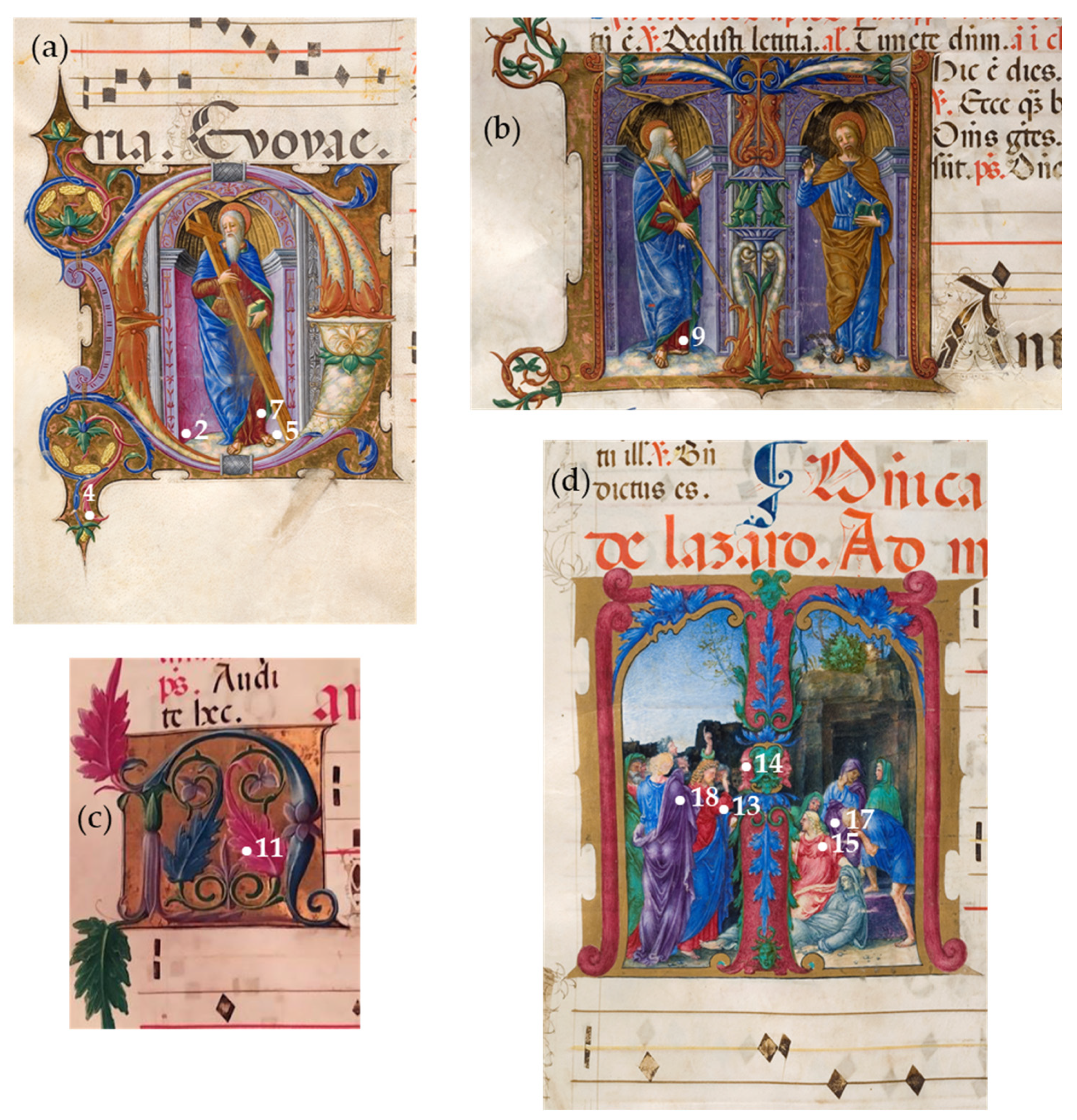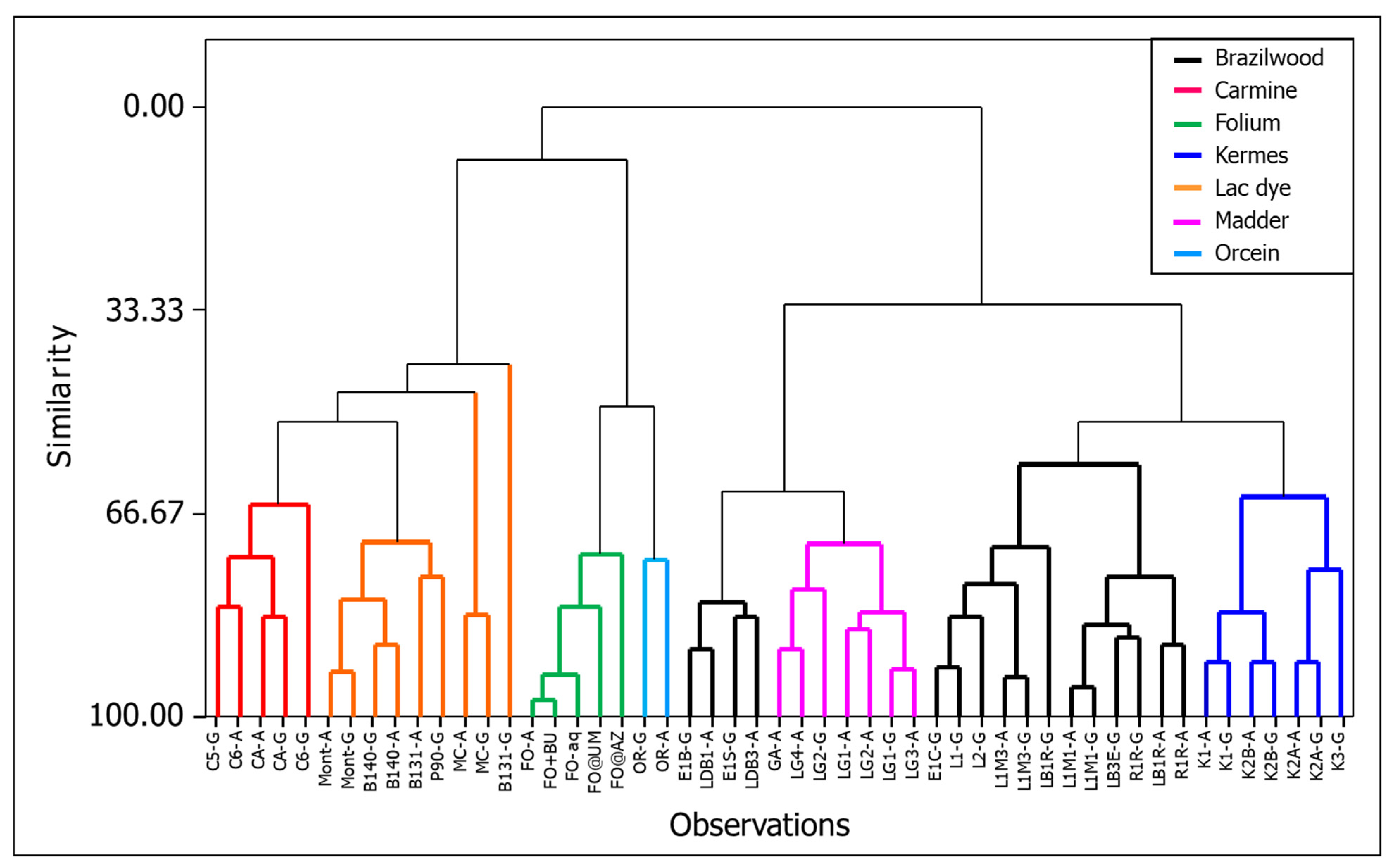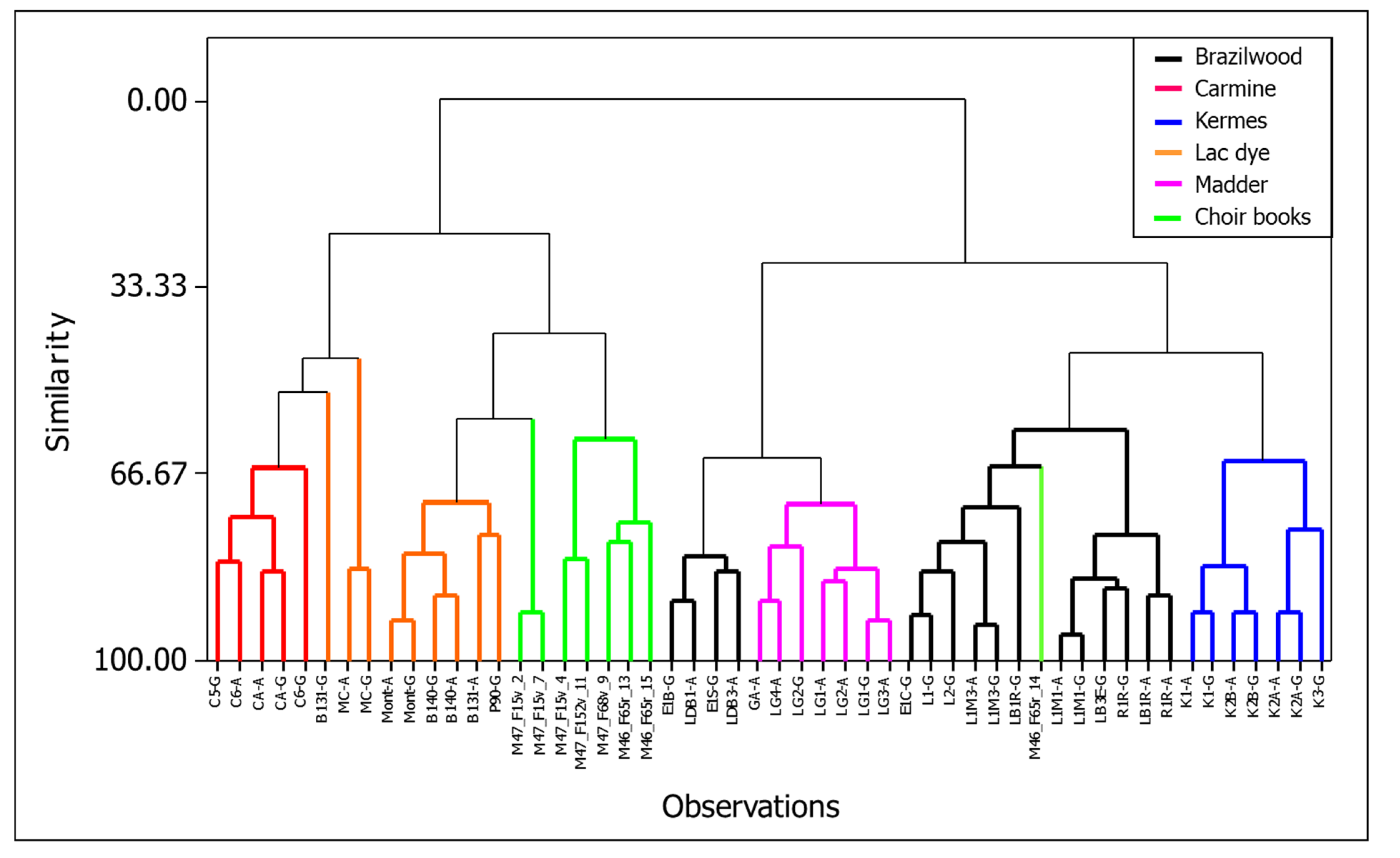Inside the Scriptorium: Non-Invasive In Situ Identification of Dyes in Illuminated Manuscripts by Microspectrofluorimetry and Multivariate Analysis: The Crescenzago Choir Books (End 15th Century) as a Case Study
Abstract
1. Introduction
2. Materials and Methods
2.1. Historically Accurate Samples
2.2. The Crescenzago Choir Books
2.3. Instrumental Methods
2.4. Kubelka–Munk Correction for Self-Absorption of Fluorescence Emission
2.5. Multivariate Analysis of Data
3. Results
3.1. Optimization of the Experimental Conditions
3.2. Spectrofluorimetric Analyses by Portable Instrumentation
4. Conclusions
Supplementary Materials
Author Contributions
Funding
Institutional Review Board Statement
Informed Consent Statement
Data Availability Statement
Acknowledgments
Conflicts of Interest
References
- Aceto, M.; Calà, E.; Arrais, A.; Clericuzio, M.; Marsano, F.; Idone, A.; Davit, P.; Menghini, L.; Gulmini, M. On the identification of folium by SERS: From crude extracts to illuminated codices. J. Raman Spectrosc. 2017, 48, 530–537. [Google Scholar] [CrossRef]
- Aceto, M.; Arrais, A.; Marsano, F.; Agostino, A.; Fenoglio, G.; Idone, A.; Gulmini, M. A diagnostic study on folium and orchil dyes with non-invasive and micro-destructive methods. Spectrochim. Acta Part A Mol. Biomol. Spectrosc. 2015, 142, 159–168. [Google Scholar] [CrossRef]
- Calà, E.; Salis, A.; Damonte, G.; Signorello, S.; Brenner, E.; Carey, J.; Aceto, M. Identification of aloe and other dyes by means of SERS and HPLC-DAD-MS in the embroidery of a 15th century English folded almanac. Dye. Pigment. 2021, 194, 109578. [Google Scholar] [CrossRef]
- Castro, R.; Pozzi, F.; Leona, M.; Melo, M.J. Combining SERS and microspectrofluorimetry with historically accurate reconstructions for the characterization of lac dye paints in medieval manuscript illuminations. J. Raman Spectrosc. 2014, 45, 1172–1179. [Google Scholar] [CrossRef]
- Melo, M.J.; Nabais, P.; Guimarães, M.; Araújo, R.; Castro, R.; Oliveira, M.C.; Whitworth, I. Organic dyes in illuminated manuscripts: A unique cultural and historic record. Philos. Trans. R. Soc. A Math. Phys. Eng. Sci. 2016, 374, 50. [Google Scholar] [CrossRef] [PubMed]
- Aceto, M.; Agostino, A.; Fenoglio, G.; Idone, A.; Gulmini, M.; Picollo, M.; Ricciardi, P.; Delaney, J.K. Characterisation of colourants on illuminated manuscripts by portable fibre optic UV-visible-NIR reflectance spectrophotometry. Anal. Methods 2014, 6, 1488–1500. [Google Scholar] [CrossRef]
- Aceto, M.; Idone, A.; Agostino, A.; Fenoglio, G.; Gulmini, M.; Baraldi, P.; Crivello, F. Non-invasive investigation on a VI century purple codex from Brescia, Italy. Spectrochim. Acta—Part A Mol. Biomol. Spectrosc. 2014, 117, 34–41. [Google Scholar] [CrossRef]
- Aceto, M.; Calà, E.; Agostino, A.; Fenoglio, G.; Labate, M.; Förstel, C.; Denoël, C.; Quandt, A. Non-invasive study on the sinope gospels. Heritage 2020, 3, 1269–1278. [Google Scholar] [CrossRef]
- Aceto, M.; Agostino, A.; Fenoglio, G.; Baraldi, P.; Zannini, P.; Hofmann, C.; Gamillscheg, E. First analytical evidences of precious colourants on Mediterranean illuminated manuscripts. Spectrochim. Acta—Part A Mol. Biomol. Spectrosc. 2012, 95, 235–245. [Google Scholar] [CrossRef]
- Gulmini, M.; Idone, A.; Diana, E.; Gastaldi, D.; Vaudan, D.; Aceto, M. Identification of dyestuffs in historical textiles: Strong and weak points of a non-invasive approach. Dye. Pigment. 2013, 98, 136–145. [Google Scholar] [CrossRef]
- Nabais, P.; Melo, M.J.; Lopes, J.A.; Vitorino, T.; Neves, A.; Castro, R. Microspectrofluorimetry and chemometrics for the identification of medieval lake pigments. Herit. Sci. 2018, 6, 13. [Google Scholar] [CrossRef]
- Nabais, P.; Melo, M.J.; Lopes, J.A.; Vieira, M.; Castro, R.; Romani, A. Organic colorants based on lac dye and brazilwood as markers for a chronology and geography of medieval scriptoria: A chemometrics approach. Herit. Sci. 2021, 9, 32. [Google Scholar] [CrossRef]
- Vitorino, T.; Melo, M.J.; Carlyle, L.; Otero, V. New insights into brazilwood lake pigments manufacture through the use of historically accurate reconstructions. Stud. Conserv. 2016, 61, 255–273. [Google Scholar] [CrossRef]
- Melo, M.J.; Otero, V.; Vitorino, T.; Araújo, R.; Muralha, V.S.F.; Lemos, A.; Picollo, M. A spectroscopic study of Brazilwood paints in medieval books of hours. Appl. Spectrosc. 2014, 68, 434–443. [Google Scholar] [CrossRef] [PubMed]
- Nabais, P.; Castro, R.; Lopes, G.V.; de Sousa, L.C.; Melo, M.J. Singing with light: An interdisciplinary study on the medieval Ajuda Songbook. J. Mediev. Iber. Stud. 2016, 8, 283–312. [Google Scholar] [CrossRef]
- Castro, R.; Miranda, A.; Melo, M.J. Interpreting lac dye in medieval written sources: New knowledge from the reconstruction of recipes relating to illuminations in Portuguese manuscripts. Sources Art Technol. Back Basics 2016, 1918, 88–99. [Google Scholar]
- Aceto, M.; Calà, E.; Agostino, A.; Fenoglio, G.; Idone, A.; Porter, C.; Gulmini, M. On the identification of folium and orchil on illuminated manuscripts. Spectrochim. Acta Part A Mol. Biomol. Spectrosc. 2017, 171, 461–469. [Google Scholar] [CrossRef]
- Ricciardi, P.; Delaney, J.K.; Glinsman, L.; Thoury, M.; Facini, M.; de la Rie, E.R. Use of visible and infrared reflectance and luminescence imaging spectroscopy to study illuminated manuscripts: Pigment identification and visualization of underdrawings. Proc. SPIE 2009, 7391, 739106. [Google Scholar]
- Zaffino, C.; Bertagna, M.; Guglielmi, V.; Dozzi, M.V.; Bruni, S. In-situ spectrofluorimetric identification of natural red dyestuffs in ancient tapestries. Microchem. J. 2017, 132, 77–82. [Google Scholar] [CrossRef]
- Clementi, C.; Miliani, C.; Verri, G.; Sotiropoulou, S.; Romani, A.; Brunetti, B.G.; Sgamellotti, A. Application of the Kubelka-Munk correction for self-absorption of fluorescence emission in carmine lake paint layers. Appl. Spectrosc. 2009, 63, 1323–1330. [Google Scholar] [CrossRef]
- Verri, G.; Clementi, C.; Comelli, D.; Cather, S.; Piqué, F. Correction of ultraviolet-induced fluorescence spectra for the examination of polychromy. Appl. Spectrosc. 2008, 62, 1295–1302. [Google Scholar] [CrossRef]
- Orna, M.V.; Fontani, M. The Modernity of Ancient Pigments: A Historical Approach. Colorants 2022, 1, 307–346. [Google Scholar] [CrossRef]
- Brunello, F. De Arte Illuminandi: E Altri Trattati sulla Tecnica della Miniatura Medievale; Neri Pozza Editore: Vicenza, Italy, 1975. [Google Scholar]
- Baraldi, P.; Fagnano, C.; Bensi, P. Raman study of a ‘Tabula Colorum Physiologica’ in a 1686 printed journal. J. Raman Spectrosc. 2006, 37, 1104–1110. [Google Scholar] [CrossRef]
- Harley, R.D. Artist’s Pigments c. 1600–1835. A Study in English Documentary Sources; Butterworth Scientific: London, UK, 1982. [Google Scholar]
- Melo, M.J.; Castro, R. O Livro de Como se Fazem as Cores: Medieval Colours for Practitioners. Online Edition. 2016. Available online: https://www.dcr.fct.unl.pt/LivComoFazemCores (accessed on 18 December 2022).
- Merrifield, M.P. Medieval and Renaissance Treatises on the Arts of Painting: Original Texts with English Translations; Dover Publications: New York, NY, USA, 1967. [Google Scholar]
- Hofenk de Graaf, J.H. The Colourful Past. Origins, Chemistry and Identification of Natural Dyestuffs; Archetype Publications: London, UK, 2004. [Google Scholar]
- Schweppe, H.; Winter, J. Madder and Alizarin. In Artists’s Pigments; West Fitzhugh, E., Ed.; National Gallery of Art: Washington, DC, USA, 1997; Volume 3, pp. 109–142. [Google Scholar]
- Kirby, J.; Spring, M.; Higgitt, C. The technology of eighteenth- and nineteenth-century red lake pigments. Natl. Gall. Tech. Bull. 2007, 28, 69–95. [Google Scholar]
- Grazia, C.; Clementi, C.; Miliani, C.; Romani, A. Photophysical properties of alizarin and purpurin Al(iii) complexes in solution and in solid state. Photochem. Photobiol. Sci. 2011, 10, 1249–1254. [Google Scholar] [CrossRef]
- Clarke, M. Mediaeval Painters’ Materials and Techniques The Montpellier Liber Diversarum Arcium; Archetype Publications: London, UK, 2011. [Google Scholar]
- Smith, C.S.; Hawthorne, J.G. Mappae Clavicula: A Little Key to the World of Medieval Techniques; Transactio. Am. Philos. Soc. 1974, 64, 1–128. [Google Scholar] [CrossRef]
- Schweppe, H.; Roosen-Runge, H. Carmine—Cochineal Carmine and Kermes Carmine. In Artists’ Pigments: A Handbook of Their History and Characteristics; Feller, R.L., Ed.; National Gallery of Art: Washington, DC, USA, 1986; Volume 1, pp. 255–283. [Google Scholar]
- Galli, P. A proposito del cosiddetto ‘Maestro di Crescenzago. Riv. Stor. Miniat. 2003, 8, 129–134. [Google Scholar]
- Mellini, R. I corali di Santa Maria Rossa di Crescenzago e la miniatura lombarda rinascimentale. Paragone. Arte 1996, 47, 127–143. [Google Scholar]
- Mulas, P.L. Six antiphonaires ambrosiens enluminés. Art Enluminure 2010, 23, 2–65. [Google Scholar]
- Mulas, P.L. I Corali di Crescenzago. Tesori della Biblioteca Capitolare di Sant’Ambrogio; Iconograf: Bergamo, Italy, 2016. [Google Scholar]
- Baroffio, G. Iter Liturgicum Ambrosianum. Inventario sommario di libri liturgici ambrosiani. Aevum 2000, 74, 583–603. [Google Scholar]
- Celora, E. I corali ambrosiani di Crescenzago: Indagine paleografica. Vox Antiq. 2020, 16, 157–186. [Google Scholar]
- Galli, P. A proposito di Bernardino Butinone miniatore. Arte Lomb. 2003, 107, 18–23. [Google Scholar]
- Mulas, P.L. La Miniatura Lombarda nell’Ultimo Quarto del Quattrocento. In Il Libro d’ore Torriani. Volume di Commento; Panini: Modena, Italy, 2009; pp. 11–83. [Google Scholar]
- Talsky, G.; Ristić-Šolajić, M. High-resolution/higher-order derivative spectrophotometry for identification and estimation of synthetic organic pigments in artists’ paints. Anal. Chim. Acta 1987, 196, 123–134. [Google Scholar] [CrossRef]
- Talsky, G.; Mayring, L.; Kreuzer, H. High-Resolution, Higher-Order UV/VIS Derivative Spectrophotometry. Angew. Chem. 1978, 17, 785–799. [Google Scholar] [CrossRef]
- Green, G.L.; O’Haver, T.C. Derivative Luminescence Spectrometry. Anal. Chem. 1974, 46, 2191–2196. [Google Scholar] [CrossRef]
- Longoni, M.; Freschi, A.; Cicala, N.; Bruni, S. Non-invasive identification of synthetic organic pigments in contemporary art paints by visible–excited spectrofluorimetry and visible reflectance spectroscopy. Spectrochim. Acta Part A Mol. Biomol. Spectrosc. 2020, 229, 117907. [Google Scholar] [CrossRef]
- Longoni, M.; Cacciola, E.S.; Bruni, S. UV-Excited Fluorescence as a Basis for the In-Situ Identification of Natural Binders in Historical Painting: A Critical Study on Model Samples. Chemosensors 2022, 10, 256. [Google Scholar] [CrossRef]
- Bisulca, C.; Picollo, M.; Bacci, M.; Kunzelman, D. Uv-Vis-Nir Reflectance Spectroscopy of Red Lakes in Paintings. In Proceedings of the 9th International Conference on NDT of Art, Jerusalem, Israel, 25–30 May 2008; pp. 1–7. [Google Scholar]






| Dye | Reference | Binder | Sample |
|---|---|---|---|
| Brazilwood | O Libro de komo se fazen as kores, 15th century, Chapter 9 [26] | gum arabic | L1-G |
| gum arabic | L2-G | ||
| egg white | L1M1-A | ||
| gum arabic | L1M1-G | ||
| egg white | L1M3-A | ||
| gum arabic | L1M3-G | ||
| Bolognese manuscript, 15th centuryRecipe 136 [27] | egg white | LDB1-A | |
| gum arabic | E1B-G | ||
| “Haarlem” Manuscript [28] | gum arabic | E1S-G | |
| egg white | LDB3-A | ||
| O Libro de komo se fazen as kores, 15th century,Chapter 9 [26] | egg white | R1R-A | |
| gum arabic | R1R-G | ||
| egg white | LB1R-A | ||
| gum arabic | LB1R-G | ||
| Madder | B. De Puyster, Use of organic dyestuffs in the manufacture of lakes, 1920 [29] | egg white | GA-A |
| L. Marcucci, Saggio analitico-chimico sopra i colori minerali e mezzi di procurarsi gli artefatti gli smalti e le vernici, 1816 [30] | egg white | LG1-A | |
| gum arabic | LG1-G | ||
| egg white | LG2-A | ||
| gum arabic | LG2-G | ||
| egg white | LG3-A | ||
| egg white | LG4-A | ||
| Carmine | Adapted from [31] | egg white | CA-A |
| gum arabic | CA-G | ||
| Paduan manuscript, late 16th–17th century [27] | gum arabic | C5-G | |
| egg white | C6-A | ||
| gum arabic | C6-G | ||
| gum arabic | LG2-G | ||
| egg white | LG3-A | ||
| egg white | LG4-A | ||
| Lac dye | Bolognese manuscript, 15th centuryRecipe 131 [27] | egg white | B131-A |
| gum arabic | B131-G | ||
| Bolognese manuscript, 15th centuryRecipe 140 [27] | egg white | B140-A | |
| gum arabic | B140-G | ||
| Paduan manuscript, late 16th–17th century [27] | gum arabic | P90-G | |
| Montpellier manuscript, 15th century [32] | gum arabic | Mont-G | |
| egg white | Mont-A | ||
| Mappae Clavicula, 12th century [33] | egg white | MC-A | |
| gum arabic | MC-G | ||
| Kermes | Manuscripts of Jehan Le Bégues (Experimenta de Coloribus), 15th centuryRecipe 11 [34] | egg white | K1-A |
| gum arabic | K1-G | ||
| egg white | K2a-A | ||
| gum arabic | K2a-G | ||
| egg white | K2B-A | ||
| gum arabic | K2B-G | ||
| Bolognese Manuscript, 15th centuryRecipe 110 [27] | gum arabic | K3-G | |
| Orcein | Adapted from [2] | gum arabic | OR-G |
| egg white | OR-A | ||
| Folium | De Arte Illuminandi, 14th century [23] | egg white | FO-A |
| water | FO-Aq | ||
| mixed with burnt umber | FO+BU | ||
| on azurite | FO@AZ | ||
| on ultramarine | FO@UL |
Disclaimer/Publisher’s Note: The statements, opinions and data contained in all publications are solely those of the individual author(s) and contributor(s) and not of MDPI and/or the editor(s). MDPI and/or the editor(s) disclaim responsibility for any injury to people or property resulting from any ideas, methods, instructions or products referred to in the content. |
© 2023 by the authors. Licensee MDPI, Basel, Switzerland. This article is an open access article distributed under the terms and conditions of the Creative Commons Attribution (CC BY) license (https://creativecommons.org/licenses/by/4.0/).
Share and Cite
Longoni, M.; Hopes, N.; Rossi, F.; Tessera, M.R.; Petoletti, M.; Bruni, S. Inside the Scriptorium: Non-Invasive In Situ Identification of Dyes in Illuminated Manuscripts by Microspectrofluorimetry and Multivariate Analysis: The Crescenzago Choir Books (End 15th Century) as a Case Study. Heritage 2023, 6, 2006-2019. https://doi.org/10.3390/heritage6020108
Longoni M, Hopes N, Rossi F, Tessera MR, Petoletti M, Bruni S. Inside the Scriptorium: Non-Invasive In Situ Identification of Dyes in Illuminated Manuscripts by Microspectrofluorimetry and Multivariate Analysis: The Crescenzago Choir Books (End 15th Century) as a Case Study. Heritage. 2023; 6(2):2006-2019. https://doi.org/10.3390/heritage6020108
Chicago/Turabian StyleLongoni, Margherita, Noemi Hopes, Federico Rossi, Miriam Rita Tessera, Marco Petoletti, and Silvia Bruni. 2023. "Inside the Scriptorium: Non-Invasive In Situ Identification of Dyes in Illuminated Manuscripts by Microspectrofluorimetry and Multivariate Analysis: The Crescenzago Choir Books (End 15th Century) as a Case Study" Heritage 6, no. 2: 2006-2019. https://doi.org/10.3390/heritage6020108
APA StyleLongoni, M., Hopes, N., Rossi, F., Tessera, M. R., Petoletti, M., & Bruni, S. (2023). Inside the Scriptorium: Non-Invasive In Situ Identification of Dyes in Illuminated Manuscripts by Microspectrofluorimetry and Multivariate Analysis: The Crescenzago Choir Books (End 15th Century) as a Case Study. Heritage, 6(2), 2006-2019. https://doi.org/10.3390/heritage6020108







